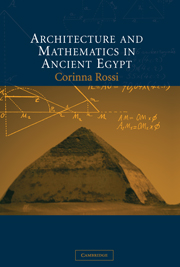Book contents
- Frontmatter
- Contents
- List of illustrations
- List of tables
- Preface
- Acknowledgments
- List of abbreviations
- Part I Proportions in ancient Egyptian architecture
- Introduction to Part I: Harmony and proportions in architecture
- 1 In search of ‘the rule’ for ancient Egyptian architecture
- 2 Mathematics and architecture in ancient Egypt
- Conclusion to Part I: Ancient mathematics and practical operations
- Part I Ancient Egyptian sources: construction and representation of space
- Part III The geometry of pyramids
- Conclusion to Part III: Interpreting the slope of pyramids
- An overview
- Appendix: List of Old and Middle Kingdom true pyramids
- Bibliography
- Index
Introduction to Part I: Harmony and proportions in architecture
Published online by Cambridge University Press: 27 February 2010
- Frontmatter
- Contents
- List of illustrations
- List of tables
- Preface
- Acknowledgments
- List of abbreviations
- Part I Proportions in ancient Egyptian architecture
- Introduction to Part I: Harmony and proportions in architecture
- 1 In search of ‘the rule’ for ancient Egyptian architecture
- 2 Mathematics and architecture in ancient Egypt
- Conclusion to Part I: Ancient mathematics and practical operations
- Part I Ancient Egyptian sources: construction and representation of space
- Part III The geometry of pyramids
- Conclusion to Part III: Interpreting the slope of pyramids
- An overview
- Appendix: List of Old and Middle Kingdom true pyramids
- Bibliography
- Index
Summary
Throughout the whole history of architecture, the concept of harmony has been the subject of numerous studies and long-lasting discussions. Harmony may be defined as a correspondence between parts, the result of the composition (or the division) of a whole into consonant parts. Its ancient link with music, where ‘agreeable’ combinations of sounds can be read as mathematical relationships, seems to seal the connection between harmony and mathematics. In art and architecture, however, this correspondence is not easily described. Although it is undeniable that a link between architecture and geometry (and therefore mathematics in general) exists, in different periods the nature of this connection has been identified and judged in different ways.
To Pythagoras and the Pythagoreans is attributed the discovery that tones can be measured in space – that is, that musical consonances correspond to ratios of small whole numbers. If two strings vibrate in the same conditions, the resulting sounds depend on the ratios between their length. The ratio 1:2, for instance, generates a difference of one octave (diapason), the ratio 2:3 produces an interval of one fifth (diapente), and the ratio 3:4 corresponds to a difference of one fourth (diatessaron). The addition of two intervals results in the multiplication of the two numerical ratios, the subtraction corresponds to a division and, therefore, halving an interval equals extracting a square root.
The Pythagorean interest in numbers, as filtered by Plato, generated a tradition that linked philosophy and mathematics in the interpretation of the cosmos.
- Type
- Chapter
- Information
- Architecture and Mathematics in Ancient Egypt , pp. 2 - 6Publisher: Cambridge University PressPrint publication year: 2004



